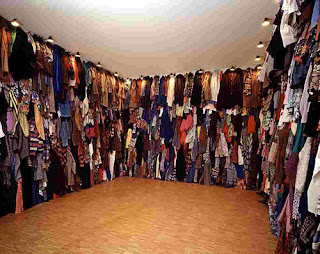
It looks like hospital cords connecting the children together and strung around to represent the life of them. To me it shows that these kids were once living, but now they're just a picture on the wall. The cords are placed all around each picture/head of the children and then are connected to each other below.

This looks like it's representing all the clothes from the Jews before entering into the concentration camps. (I haven't read the information about Boltanski's work yet). I've been to the Holocaust Museum in New York (I think) and they have heaps of shoes from the victims in the camps. This reminds me of that. The only thing is that these clothes don't look very old, so i'm assuming they're not the real clothes from back then.

Here, it almost looks like a combination of the first piece with the second piece. There are folded clothes placed beneath the photos. Something that's different here is that there are lamps placed over each photo that's illuminating a little circle on each face. The cords come down into the clothes. I'm not sure what I get out of the lights.
The last piece is different from the rest. I wasn't really sure about this one, but it looks like it's supposed to be scary.

There's some kind of wire contraption with skeletons hanging off, like they were people who were hung. There are also heads with weird long noses, maybe representing liars? I see mean looking faces and scared looking faces also. The wire contraption and everything is in the center of a room, small and is illuminated as shadows on the walls of the room.
I read that Christian Boltanski's work is obsessed with death. That didn't surprise me. He works with social, economic problems as well. I feel like my assumptions about this artist were close to what he is about. His work seems to be what it is, death.








